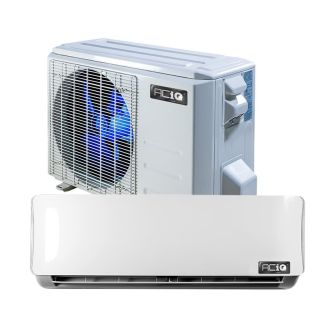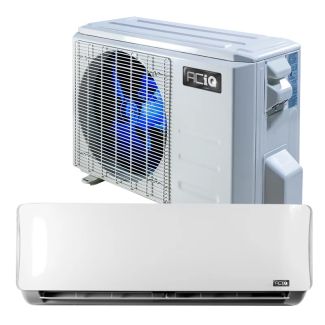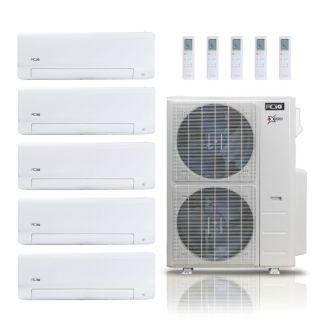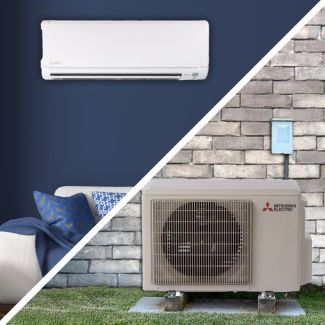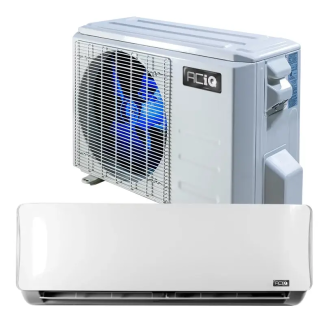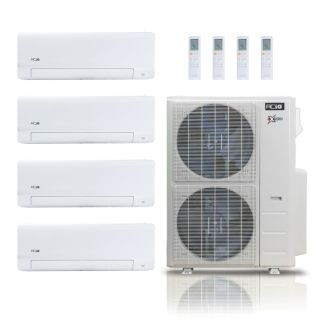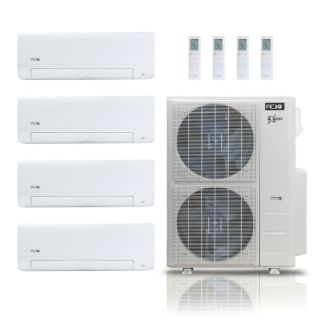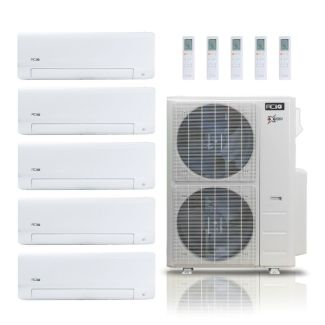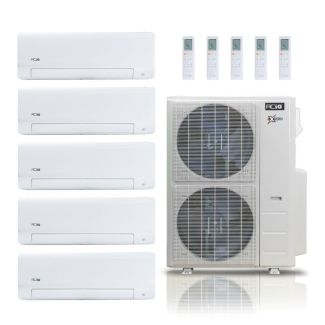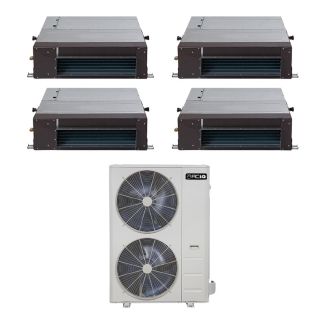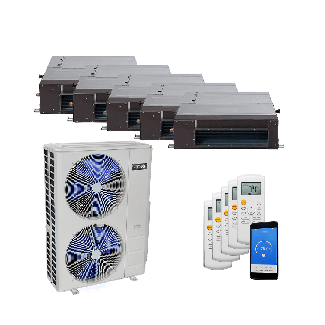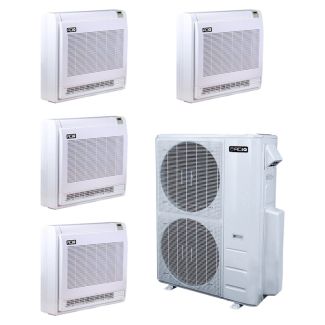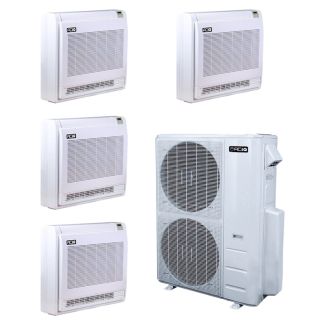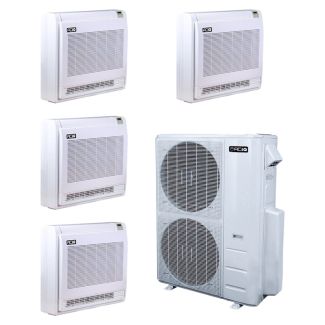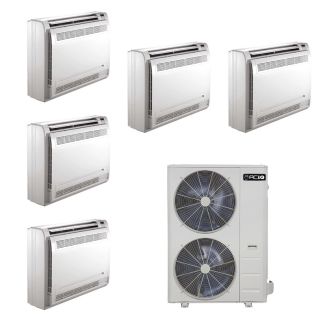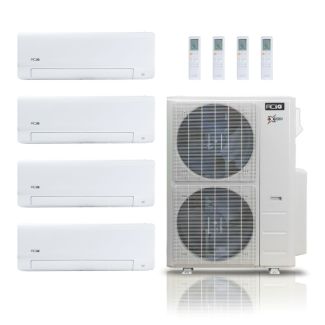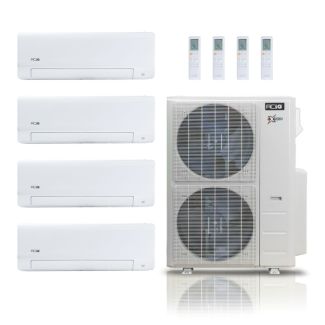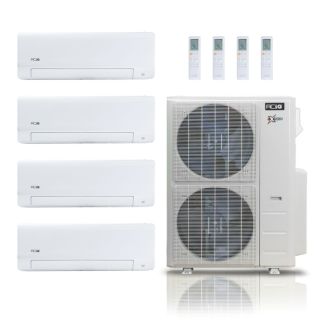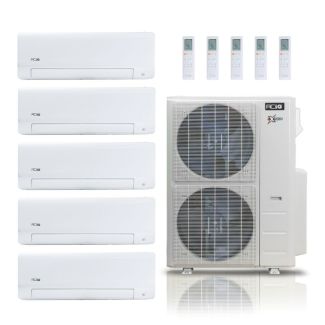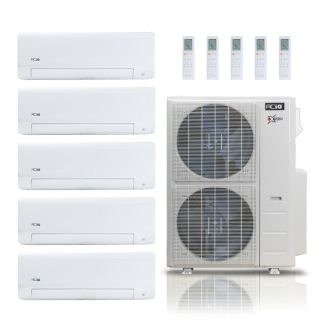A ductless mini split air conditioner presents a contemporary approach to indoor climate management, offering unique advantages that distinguish it from traditional central air systems. Unlike centralized air conditioning, which relies on ducts to circulate air throughout a home, ductless mini splits operate on a zone-by-zone basis. Each room or zone is equipped with its own sleek air handler, typically mounted inconspicuously on a wall or ceiling, and connected to an outdoor compressor unit via a small conduit. This configuration enables precise temperature control tailored to individual preferences in each zone, enhancing comfort and optimizing energy usage by only conditioning occupied spaces. The absence of ductwork eliminates energy losses associated with air leakage, resulting in greater efficiency and reduced energy costs over time. The mini split heat pump operating as a ductless HVAC system, delivers both heating and cooling capabilities in a single unit, offering flexible comfort solutions throughout the year. By extracting heat from the outdoor air and transferring it indoors during colder months, mini split heat pumps offer energy-efficient heating without the need for ductwork. The versatility of ductless mini splits extends to installation options, making them suitable for various architectural styles and configurations. Whether in new constructions or existing homes, the absence of ductwork allows for easier and less invasive installation, minimizing disruption to the living space. Many ductless mini split models come equipped with advanced features such as remote control and Wi-Fi connectivity, enabling convenient monitoring and adjustment of settings from anywhere via smartphone apps or other smart devices. This level of control empowers homeowners to manage their indoor environment efficiently and effortlessly.
Ductless Mini Split Systems
Subcategories
R410a Mini Split Systems Still Available
Mini Split Systems are Perfect for 100's of Applications
- Residential
- Fitness Centers
- Studios
- Mobile Offices
- Green Houses
- Small Businesses
- Mobile Homes
- Restaurants
- Garages
- Modular Buildings
- Churches
- Daycares
Shop for DIY Options
Shop by Mini Split Mount Type
Shop Mini Splits by BTU
Featured Mini Split Videos
Why Choose HVACDirect.com?
At HVACDirect.com, we combine unbeatable prices with expert support to give you the best online shopping experience for mini split equipment. Whether you're a homeowner, contractor, or business owner, you'll find a massive selection of top brands—like MRCOOL, Mitsubishi, Daikin, and more—all backed by fast shipping, factory warranties, and U.S.-based technical support. As a trusted HVAC supplier for over 20 years, we make it easy to find the right system at the right price—no middleman, no markup, just direct value.
FAQs
The installation process for a mini split system is much easier than that of a traditional system. This comes from the inherent simplicity of a mini split unit. Ductless mini split air conditioner systems consist of two main parts. The first is an outdoor compressor or condenser. This is paired with one or more indoor air handling units (these are the devices that you can see inside a structure, as they actively heat and cool rooms). Another great feature of ductless air is the variety of air handlers available, including:
- Wall Mounted
- Ceiling Cassette
- Concealed Duct
- Floor Mounted
Mini split AC installation is remarkably simple, especially when compared to the need to build out complex duct networks for a central air system. Most installations follow a 4-step process:
- Installing the condenser (this happens outside)
- Running refrigerant lines through a 3-inch hole in the exterior wall
- Installing the air handlers (these go indoors) and attaching them to the refrigerant lines
- HVAC technician charges the system by vacuuming the line sets
Understanding a cutting-edge heating and cooling solution is one thing. Deciding whether it’s right for you is another question altogether. By now industry professionals across the board understand that ductless systems are no longer “new” or “the future of HVAC.” The reality is here. Now, mini splits are a major sector of the HVAC marketplace. Billions of dollars are spent each year on both DIY and professionally-installed ductless systems. The main decision for contractors, builders, architects, and homeowners is very simple. Ask yourself: “Am I using ducts, replacing ducts, or eliminating ducts?”
The primary benefits that come from using a mini split include:
- Efficiency: The use of independent handlers means less overall power to run the system.
- Zone Climate Control: This equates to energy savings.
- No Ductwork: This makes for an easy and accessible installation.
- Flexible Designs: The ability to design systems that work with the needs of each room in a building.
- Noise: The absence of ductwork makes these units one of the stealthiest ways to cool or heat a home.
Efficiency
Mini split systems tend to be a lot more efficient than your typical central split systems. Many mini splits boast high SEER ratings. (SEER is short for seasonal energy efficiency ratio and is an industry standard for measuring the efficiency of air conditioners.) SEER for mini split systems is often impressive. The ratios usually range from 18 SEER all the way up to an amazing 42 SEER. With ratings like that, your future system will be able to reduce your energy bills significantly compared to other heating and cooling solutions. These efficiencies also qualify for various rebates as well, which is another incentive to consider.
Zone Climate Control
Have you ever wanted different rooms in your house set at different temperatures? Multi-zone mini split systems allow you to keep each zone at a different temperature. This gives you the power to control the temperatures throughout your house easily and keep each area exactly the way you want.
No Ductwork
Ductless mini split systems are exactly what their names would lead you to think they are — ductless. Instead of ducts, they use copper line sets to run refrigerant to the indoor units. The lack of ducts offers an easy workaround. It makes these ventless air conditioner systems an especially smart choice when installing ductwork would be too costly, difficult, or unnecessary. This allows you to place your air handler directly in the space where you want it. When it comes to caring for your system over time, it also means you won’t have to invest in as much maintenance. This contributes to the versatility and ease of mini splits for homeowners.
Scalability
One of the major appeals of mini split systems is that they’re able to adapt to the sizing needs of a home. They offer homeowners and builders alike real convenience, simplicity, and affordability. They can even grow with a structure if you build an addition in the future. Mini splits are available to control anywhere from one to eight zones. The typical home will need four or five indoor air handlers. These air handlers are available in a variety of mounting options, including wall, floor, and ceiling mounts, making them easy to fit into any space. Homeowners can even mix and match air handler types to adjust to certain conditions.
Noise
Ductless mini split systems, and specifically the inside handler units, have sound ratings as low as 19 dBA. With sound ratings that low, it means that they can operate quieter than a whisper. This allows you to stay comfortable without being distracted by annoying noises.
One of the biggest concerns about a mini split is if it uses too much electricity. The primary issue here is identifying the correct sizing of units for each zone in your home in order to assure maximum efficiency. (Again, refer to our sizing guide linked above to make sure you get precisely the size unit you need).
At the end of the day, the cost of running a mini split will depend on various factors, from the units you choose and how you use them to your environment and home’s energy efficiency. If you’re concerned about electricity consumption, you can use a mini split energy consumption calculator to compare a unit to your current cooling costs.
Mini splits can save you an incredible amount of money, primarily by removing the need to install ductwork throughout your home. In addition, there are the financial benefits of improved efficiency and the associated mini split heater rebates, which can save homeowners hundreds.
Even when shopping for the best mini split AC or heating units, you can save cash. You can use a site like ours to look for a mini split AC for sale and shop discounted mini split heaters too. From MRCOOL mini splits to any of our other name brands such as: Fujitsu, Mitsubishi, Infinity Living, and more, HVAC Direct can ensure that you get the best mini split AC and heater units at a good price.
When comparing mini split versus central air, another factor to consider is the number of handling units you’ll need. Fortunately, a mini split handler doesn’t have to be restricted to a single space. If positioned correctly, the cold or warm air can flow between closely connected areas of a home, allowing a unit to control the climate in a larger area.
With that said, these are still units that are meant to be used in larger numbers. So plan on purchasing at least a couple of handlers — unless you’re cooling a studio apartment.
Another question to consider is whether you need heat, air, or both. Mini split systems can do both, but you want to get the right equipment.
HVACDirect.com carries a wide variety of mini splits, meaning you can find exactly what you need for your situation. For instance, a mini split ductless AC unit can offer an affordable and efficient solution for your cooling needs.
If you live in an area where the temperature doesn’t drop below zero, a ductless heat pump is most suitable, however, professional consultation is always recommended. If you live in a colder place, you can still use mini split heat pumps, but you might want to consider a backup heating system as well.
As is the case with any heating and cooling solution, the lifespan of your mini split heat and air unit will vary depending on a variety of factors. The quality of the unit, how well you maintain it, and how often you use it can all factor into the equation. HVACDirect.com has put together a roster of major brand partners who typically offer manufacturers warranties that run from 7 to 12 years.
With that said, you should be able to count on your unit for over a decade and possibly even two. That puts it at least on par with traditional AC units, if not better.
The million-dollar question here is: Should you invest in a multi-zone mini split AC unit?
Multi-zone mini splits can save you a lot of money. They’re also a pain-free installation option, which you can even install yourself. They’re efficient, scalable, and impressively quiet.
It’s hard to argue with the takeaway here. With lower energy bills, lower installation costs, minimal maintenance, and the ability to heat and cool your home’s zones individually, multi-zone mini splits are an excellent heating and cooling solution.













